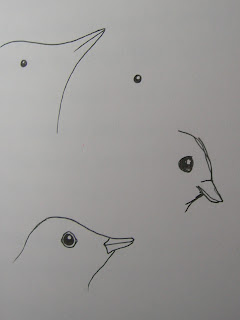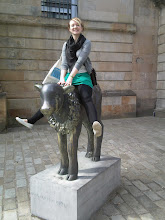
To start this project i've begun looking at ideas of saftey and security. It began when two weeks ago i found a nest in the hedge outside my bedroom window, it contained two chirrping baby birds and a mother bird who looked awfully unhappy to see me sticking my nose into thier home. She snuggled down on the little chicks so all you could see peering from underneath was one little beak nuzzling about. The chicks have since flown away and the nest seems to be abandoned but it still looks beautifull, especially as it seems secret. I dont think anyone else would know that its there?
Trying to build a replica little nest really appeals to me i found these instructions: http://www.learner.org/jnorth/tm/robin/BuildNest.html
1. Find a suitable building site
The site should be protected from sun, wind and rain. It can be anywhere from ground to treetop in height; the site must be on something sturdy enough to anchor the nest securely in place. You don't want your nest to fall off!
Your nest should also be very close to a good feeding spot so you can easily find worms while keeping an eye on it, and it shouldn't be too far from water.
Choose a spot that is hard for predators to see. Remember, you and your eggs and babies will be sitting here for the next 5 weeks, so be careful to pick a spot that's safe, cool, and comfortable.
2. Gather materials
Grass fibers: Collect about 350 dead grasses and twigs that are about 6 inches long. (The pile should weigh about 135 grams.)
Soft mud: After a soaking rain, collect mouthfuls of mud in your beak and travel back and forth to your nest site a few hundred times. (If you happen to be a person rather than a robin, you might substitute your hands for a beak to collect the mud, but don't forget that it takes a pair of robins hundreds of visits to build the nest!)
3. Build!
Weave the grasses together, cementing them to each other and to the supporting branch or windowsill with mud.
Next, use your tummy to shape the nest into a perfect baby cradle.
Finally, line the inside with the softest grasses and hairs you can find so the eggs will stay warm and not get pierced by any twigs or sharp grass edges. The nest must be tight and snug enough to cradle the eggs and hold in your warmth, but large enough to hold four or even five BIG nestlings.
This idea of sneaking yourself into a small space to keep yourself and the people you love safe got me thinking about how we all do this everyday. We make safe spaces for ourselves in our homes, bedrooms, cars, relationships, clothing, even in our own personal space and the bounderies we create. I noticed how we do this at the start of every project in the studio, we all select our little bit of wall in whats really just a big white box and make it our own, fill it with personal things important to us and what we are exploring. its a comforting thing to do and i think there are times when we all feel insecure and want to curl ourselves up into a tiny corner.




No comments:
Post a Comment